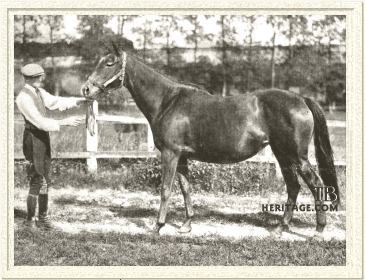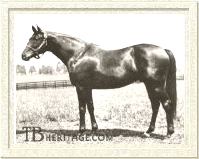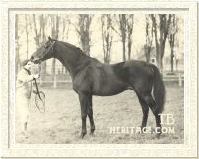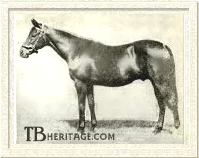|
|
Plucky Liege

|
|
 |
|
|
Plucky Liege was one of the most
important broodmares of the 20th Century. Two of her sons, *Sir Gallahad
III and *Bull Dog were leading sires in America, and two others, Bois
Roussel and Admiral Drake were sires of classic winners in England,
Ireland, and France. Few mares have sired as many important sire sons
and, as a result, wielded such far-ranging influence as this great
producer.
|

Concertina
| |
Bred in England by Lord Michelham,
Plucky Liege was a daughter of the Derby and Grand Prix de Paris winner
Spearmint. She was the twelfth foal out of the fertile but unspectacular
broodmare Concertina, a daughter of the mighty St. Simon. She began
her racing career without a name, starting in her first race as "the
Concertina filly." She was eventually named "Lucky Liege,"
which became further modified into "Plucky Liege" to honor
the town of Liege in France, whose citizens put up a courageous defense
during the First World War.
|
So named, the Spearmint filly made six
starts at two, all at five furlongs, winning four of these. Although
she wasn't a major winner, she impressed enough to earn an assignment
of 117 pounds on the Free Handicap, third among fillies, and rated
one pound behind Lady Josephine (another filly with a future).
Unfortunately, Plucky Liege disappointed
greatly at three. Her best effort in seven starts was a third going
five furlongs, beaten by the top sprinter Friar Marcus in the Queensbury
Handicap. She was also unplaced in the 1000 Guineas of that year won
by Vaucluse. Having thus proven herself speedy, precocious, yet unable
to improve off her juvenile form, she showed none of her sire's later
maturing, staying influence. Perhaps this is why she was sold to Lord
Michelham's secretary, Jefferson Davis Cohn, and took up her next
career in France as a broodmare.
Cohn had leased Haras du Bois
Roussel and installed *Teddy as his home stallion, a horse he had
purchased from breeder Edmond Blanc. There, Plucky Liege produced
12 foals in all, 11 of which were winners, and six of which won stakes,
including two classic winners.
|
| Foals
of Plucky Liege |
| Name
|
Sire
|
| *Marguerite
de Valois (f. 1919) |
*Teddy |
| *Sir
Gallahad III (c. 1920) |
*Teddy |
| Noor
Jahan (f. 1921) |
*Teddy |
| Chivalry
(c. 1922) |
Good
Luck |
| Noble
Lady (f. 1924) |
*Teddy |
| Elsa
de Brabant (f. 1926) |
*Teddy
|
| *Bull
Dog (c. 1927) |
*Teddy |
| *Quatre Bras II (c. 1928) |
*Teddy |
| *Diane
de Poitiers (f. 1929) |
*Aethelstan II |
| Admiral
Drake (c. 1931) |
Craig
an Eran |
| *Bel
Aethel (c. 1933) |
*Aethelstan II |
| Bois
Roussel (c. 1935) |
Vatout |
| |
Her first foal was *Marguerite
de Valois, a 1919 filly by *Teddy, which won four races in France.
She was imported to America carrying the colt Cleves (1931 by Sardanapale),
who was stakes-placed, but it was her last foal, Hostility, a 1936
daughter of Man o' War that continued the family tradition. Hostility
won the Acorn Stakes and placed in several others including the C.C.A.
Oaks, Gazelle, and Alabama Stakes. Hostility produced the stakes winner
Antagonism and the winner Boldness. Boldness produced the stakes winners
Correlation and Big Raff as well as the broodmare Cequillo, and it's
through Cequillo that come a flood of good runners, mainly bred by
Tartan Stable including Fappiano, Ogygian, Dr. Patches, Quiet American
and others. Another daughter, *Mademoiselle de Valois became the third
dam of champion Roman Brother.
|
Plucky Liege's second foal was
her first stakes winner, the 1920 colt by *Teddy named *Sir Gallahad III. *Sir Gallahad III's racing career was overshadowed by one of
the best colts of the era, *Epinard, but he accorded himself well
nonetheless. A winner of three races in five starts at two the Prix
Eclipse, Prix du Petit Couvert and Prix de la Mediterranee.
At
three, he won four races, the Poule d'Essai de Poulains (French 2000
Guineas), Prix Daphnis, Prix Edgard de la Charme and Prix Jacques
le Marois; he also placed second in the Prix Royal Oak and third in
the Prix du Jockey Club. At four, he won the Lincolnshire Handicap
in England, the Prix Boiard, Prix Daphins, and Prix Edgard de la Charme
and ended the season by defeating the great *Epinard in a match over
six and a half furlongs.
*Sir Gallahad III stood two seasons
in France before being purchased by an American syndicate headed by
A.B. Hancock for $125,000 and relocated to Claiborne Farm in Kentucky.
His first American crop included Triple Crown winner Gallant Fox.
He became the American Leading Sire in 1930, 1933, 1934, and 1940,
and was that country's Leading Broodmare Sire twelve times as well.
Oddly, his influence in America was for classic staying ability, while
he himself was at his best over shorter distances.
Plucky Liege's third foal was
another *Teddy filly named Noor Jahan, foaled in 1921. A winner of
three races in France, she was the dam of winners, and her most important
offspring was the filly Avella (by *Epinard), from which descend Oaks
winner Pia and Prix du Jockey Club winner Sanctus. |

Sir Gallahad III

Bull Dog

Admiral Drake. Image Courtesy M. Roger
Cornevin-Hayton.

Bois Roussel
| |
Plucky Liege's fourth foal was
the colt Chivalry, a 1922 colt by Good Luck. He won two races at three
in France but did nothing more. Her fifth foal was the equally uninspiring
*Teddy filly Noble Lady (1924), a winner of two races which left no
mark as a broodmare. Plucky Liege's fifth foal was the filly Elsa
de Brabant (1926), also by *Teddy, winner of one race at two and again,
leaving no mark as a broodmare.
In 1927, Plucky Liege again presented
her breeder with a colt by *Teddy, and the combination was once again
magic. Although not as good a runner as his older brother *Sir Gallahad III, *Bull Dog won the Prix Daphnis and Prix La Fleche d'Or, both
at a mile as a three-year-old. By this time, his brother's first American
crop was running, represented by Gallant Fox, Escutcheon, Pansy Walker,
Flying Gal, and The Scout, all stakes winners. Charles B. Shaffer
purchased *Bull Dog for $80,000 and stood him at his Coldstream Stud,
Lexington, Kentucky. *Bull Dog was also an immediate success in America
and led the sires' list in 1943, specializing in precocious, speedy
two-year-olds like Plucky Liege herself. He was also the Leading Broodmare
Sire in 1953, 1954, 1956, and 1958. His son, Bull Lea, became the
Leading Sire five times for Calumet Farm.
In 1928, Plucky Liege produced
yet another colt by *Teddy, and this one, named *Quatre Bras II, was
also a stakes winner, winning the Prix Yacowlef in France. Brought
to the United States, he was stakes-placed at five, and won two stakes,
the Fort Worth and St. Patrick's Day Handicaps, at six. He was also
placed in stakes at seven and retired to stud in Virginia, where he
sired nine stakes winners, although nothing of great class. He was
the last of the *Teddy - Plucky Liege siblings. In 1931, the 18-year-old
*Teddy was sold to America and died there in 1936.
Cohn switched Plucky Liege to
*Teddy's good son *Aethelstan II and she produced the winning filly
*Diane de Poitiers in 1929. Brought to America,*Diane de Poitiers
produced several winners, but no stakes horses and none of her daughters
bred on to any extent.
Plucky Liege produced the Craig
An Eran colt Admiral Drake in 1931, and he won five races including
the Grand Prix de Paris at three, placing second in the French 2000
Guineas and third in the French Derby. He also won the Grand International
d'Ostende at four. At stud in France, Admiral Drake was a consistently
successful sire. His best was Derby winner Phil Drake, as well as
French 2000 Guineas winner Mistral, besides Monsieur l'Amiral, and
Amour Drake. His daughter *Source Sucree produced the champion *Turn-to,
and another daughter Toute Belle II was the dam of Hard Ridden. .
|
In 1933, Plucky Liege foaled
a second colt by *Aethelstan II, this one named *Bel Aethel. He
won three races in England and France including the Prix Daru, placing
second in the Prix Edgard de la Charme and third in the Gold Vase.
Sent to America to stud, he left only 76 foals before his death at the age of 10. Of those, five won stakes (an impressive seven percent), led by Bel Reigh, Plucky Flag, and Lights Abeam.
About this time, Jefferson
Davis Cohn was getting out of the horse business. He sold all of his
stock including Plucky Liege, the stallion Vatout, and the lease on
Haras du Bois Roussel, to Leon Volterra. For Volterra, Plucky Liege
produced a brown colt by Vatout in 1935 when she was 23 years of age,
a colt which was named Bois Roussel after the famous stud farm.
In 1937, Plucky Liege's
death was reported in the Bloodhorse Breeder's Review. In March
of that year, she had produced a dead foal by Casterari and succumbed
herself a week later at the age of 25. The following year, her last
living foal, Bois Roussel, became the champion of his age in England,
winning the Epsom Derby, Prix Juigne, and running third in the Grand
Prix de Paris to Nearco and Canot. Retired to stud, Bois Roussel was
another successful sire for his dam, getting Tehran (St. Leger), Ridge
Wood, *Migoli (Arc de Triomphe), French Beige (Doncaster Cup), and
Irish Derby winners Fraise du Bois II and Hindostan. Hindostan became
a leading sire in Japan. Another son, Delville Wood became a leading
sire in Australia. Tehran sired the Irish great *Tulyar. *Migoli sired
Belmont Stakes winner *Gallant Man. Bois Roussel's daughters were
also exceptional producers. He was a tremendous influence for classic
stamina.
The remarkable life
of Plucky Liege came to an end in 1937, but the ripples of influence
descending from her through her four top sire sons, *Sir Gallahad
III, *Bull Dog, Admiral Drake, and Bois Roussel, not to mention the
offspring of her daughters Marguerite de Valois and Noor Jahan, continued
spreading outward for generations. English Derby winner Roberto carried
three of the four brothers in his pedigree, and he was linebred 5x5x7x5
to Plucky Liege. Nearly every major runner in the world today carries
at least one strain of Plucky Liege.
A couple observations
are worth noting about Plucky Liege. She was the twelfth and probably
best foal of her dam, and she herself was not only an extremely fertile
mare, producing 12 foals, but continued to produce at the highest
level right up to the end of her life. She maintained the distinction
of being the oldest 20th Century mare ever to produce an Epsom Derby
winner, which she did when she was 23. Her sons and daughters were
also generally long lived and prolific.
Secondly, it's interesting
that while two of her daughters, *Marguerite de Valois and Noor Jahan,
became influential in the long run, neither was a great runner or
considered a blue hen like their dam. On the other hand, Plucky Liege's
top sons were far above the norm as runners and sires.
The above photo
of Plucky Liege shows her in the paddocks of Haras
du Bois Roussel. She is a spare-looking, lengthy bay mare with sickle
hocks, and her left hind ankle is white. The magic was obviously deep
inside, where no one could see it but her owner, Jefferson Davis Cohn.
--Anne Peters |
|
|
|

